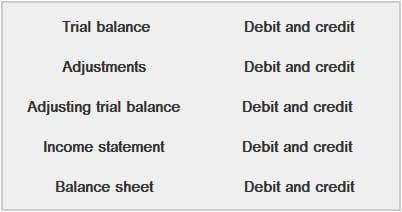A worksheet consists of two main parts: A description of these parts, each of which consists of several elements, is given in the next sections. The heading of a worksheet consists of three parts: A worksheet's body contains a large column for the names of accounts, along with 10 money columns (or 5 pairs), each pair consisting of a debit column and credit column. The 5 pairs of money columns are arranged in the following order: Later on, with practice, it is possible to eliminate the adjusted trial balance columns. In that case, the worksheet will contain 8 money columns instead of 10 money columns.
Heading
Body

Parts of a Worksheet FAQs
The heading of a worksheet consists of three parts: (a) the business name, (b) the title “worksheet”, and (c) the accounting period for which the worksheet is prepared. A worksheet's body contains 10 money columns (or 5 pairs), each pair consisting of a debit column and credit column, arranged in this order: assets, liabilities, income statement items (with some exceptions for certain businesses), stockholders' equity, expenses, dividends. The worksheet is headed by the account names from the Accounting Equation - assets = liabilities + owners' equity.
The items in the heading of a worksheet are identical to those of an adjusted Trial Balance. The body of a worksheet contains information that will be shown on the company's Financial Statements, which is not necessarily the same as that shown on the company's adjusted Trial Balance.
As defined in this tutorial, a Double-entry System is a method of accounting used to ensure that each debit entry appears with an equal and corresponding credit entry. The term “double-entry” refers to the fact that every entry requires two accounts for its recording, one account called the debit account, into which is posted the amount of the debit entry; and one account called the credit account, into which is posted the amount of the corresponding credit entry.
The words “debit” and “credit” are accounting terms that indicate whether an amount is to be entered (posted) as a positive (plus) or negative (minus) value, either on the left-hand side of an account (one who “debits”) or on the right-hand side of an account (one who “credits”). When recording transactions in accounting records, debit entries are made for expenses and losses; credit entries are made for income and gains.
An account is a record of money (or other items of value) in which the total debits must equal the total credits at all times. The term "account" can refer to either an individual or a group of accounts, depending on the context in which the term is used.
True Tamplin is a published author, public speaker, CEO of UpDigital, and founder of Finance Strategists.
True is a Certified Educator in Personal Finance (CEPF®), author of The Handy Financial Ratios Guide, a member of the Society for Advancing Business Editing and Writing, contributes to his financial education site, Finance Strategists, and has spoken to various financial communities such as the CFA Institute, as well as university students like his Alma mater, Biola University, where he received a bachelor of science in business and data analytics.
To learn more about True, visit his personal website or view his author profiles on Amazon, Nasdaq and Forbes.











